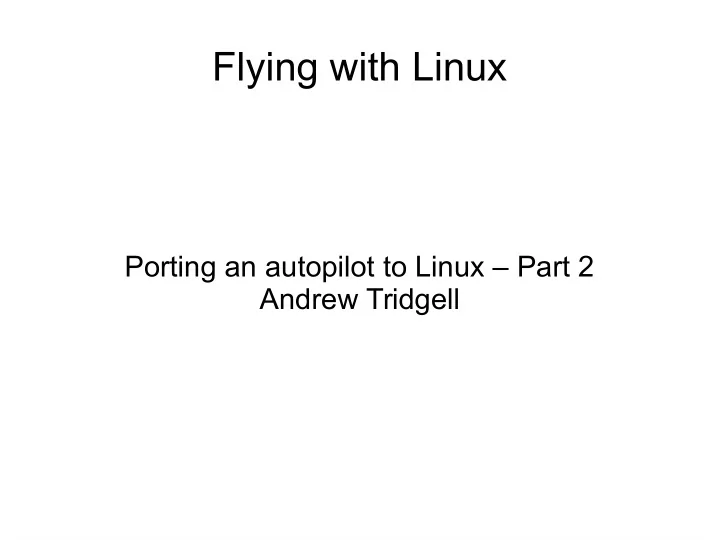

Flying with Linux Porting an autopilot to Linux – Part 2 Andrew Tridgell
LCA last year ● Initial port of ArduPilot to Linux ● Base design of PXF sensor cape done, but not built yet ● Didn't know how much of the autopilot code could realistically run on Linux
Existing System Design
New System Design
PixHawk Fire Cape
In the last year... ● ArduPilot is now regularly flying on Linux ● multiple ports of ArduPilot have been done to a variety of different boards ● Autopilots based on ArduPilot on Linux are now commercially available
Flight Demonstration Live demo from Canberra, Australia ● Skywalker 2013 electric model ● BeagleBoneBlack with PXF cape ● ArduPilot 3.2.1 ● Compilng Linux kernel while flying on same CPU
Demo Setup ● BeagleBoneBlack running Debian – 3.8.13-RT kernel – ArduPilot 3.2.1 ● Sensors – MPU9250 accel/gyro on SPI – MS5611 barometer on SPI – Ublox Lea6H GPS on 38400 UART – HMC5883 compass on I2C – MS4525DO airspeed sensor on I2C ● IO – SBUS input via PRU2 – PWM output via PRU1 – two telemetry radios (for MAVLink and shell access)
Autopilot boards and ports ● Flying ports developed over the last year – PXF/BBB from 3DRobotics – Erle Brain from Erle Robotics (PXF on BBB cape) – NavIO and NavIO+ RPi capes from Emlid ● Prototype ports – I.MX6 port within 3DRobotics – Zynq ARM+FPGA port by John Williams – BBBMini port by Mirkix
I2C and SPI ● Fast sensors on SPI – using /dev/spidev interface, user-space drivers – works very well! – able to handle 4k SPI transactions per second with 25% CPU load on BBB – no DMA used due to DMA overhead for small transfers (typically a transfer is around 20 bytes) ● Slower sensors on I2C – using /dev/i2c smbus API, drivers in user space ● Why user space? – common drivers across multiple operating systems, using AP_HAL abstraction ● Moving to uavcan in future to replace most I2C
Scheduling ● 6 realtime (FIFO scheduled) threads – timer thread (1kHz timer, for regular tasks) – UART thread for all UART serial operations – RCIN thread for processing RC input pulses – main thread for core autopilot code – tonealarm thread for buzzer sounds – IO thread for all filesystem IO (logging, parameters and terrain data)
Scheduling Overrun ● Long scheduling overrun discovered – discovered while preparing for this talk – 11 hour test, building kernel on microSD while ardupilot running on BBB – 50Hz main loop, so 20ms expected loop time – Out of 2M loops executed, 19 were over 30ms – one was over 40ms – that took 1.7 seconds! – the challenge now is to find the cause and fix it
PRU Code ● Programmable Realtime Units – two PRUs on BeagleBoneBlack – 200MHz simple CPUs – access to 8k of shared memory with ARM – direct access to I/O pins – C Compiler available (not complete, but usable)
High rate timing task – RC Input ● Some tasks need microsecond precision – RC Input ● PPM-SUM (multi-channel pulse width based RC-input) ● SBUS (100kbaud inverted serial RC input) ● DSM (115200 baud serial RC-input with framing) – We needed a solution that was as generic as possible ● In AP_HAL each board calls process_rc_pulse() for each state change of pin ● Commonly implemented using a ring buffer (pulse train) ● Generic software decoder handles all 3 protocols in parallel ● Decoding of multiple baud rates on one pin (protocol framing to avoid ambiguity) ● Avoids the need for multiple UARTs for RC input
BeagleBoneBlack PRUs ● PRU1 used for RC Input – watches for state change on 1 pin – writes timing of state changes to a ring buffer – ARM code consumes entries from ring buffer, calling process_rc_pulse() – just 70 lines of C code on PRU ● PRU2 used for PWM output – shared buffer of PWM channel pulse width frequency – continuously reads shared buffer and updates 12 channels – just 235 lines of C on PRU
Outback Challenge 2014
DroneCode.org ● New umbrella organisation for free software UAV development – Part of Linux Foundation Collaborative Projects – Forum for collaboration between projects, users and companies using the technology ● First conference – First DroneCode conference at ELC in San Jose in March 2015 – Come along!
Recommend
More recommend